Diy Sensory Table for Autism
Enhancing Autism Therapy with DIY Sensory Tables

Exploring the Impact of Sensory Tables in Autism Support
Sensory tables are powerful tools widely used in therapeutic settings to help children with autism navigate sensory processing challenges. This article explores how to create and utilize a DIY sensory table tailored for autism, highlighting its benefits, components, and integration with behavioral therapies such as Applied Behavior Analysis (ABA). By understanding the sensory needs of autistic children and combining sensory play with evidence-based interventions, caregivers and educators can foster development in multiple skill areas.
Understanding Applied Behavior Analysis (ABA) Therapy

What is Applied Behavior Analysis (ABA) therapy?
Applied Behavior Analysis (ABA) therapy is a scientifically grounded approach that uses principles of learning and behavior to help individuals, primarily those with autism spectrum disorder, develop useful skills and reduce problematic behaviors. It involves personalized programs designed by trained behavior analysts (BCBAs) who utilize techniques such as positive reinforcement, data collection, and behavior modification strategies based on the ABCs—Antecedent, Behavior, Consequence.
Core principles and techniques
At the heart of ABA therapy are several foundational principles. Positive reinforcement encourages desired behaviors by rewarding them, thereby increasing their frequency. Data collection plays a vital role, allowing therapists to monitor progress and modify strategies accordingly. Other techniques include task analysis, discrete trial training, and natural environment teaching, which are tailored to each child's needs and environment.
Importance in autism intervention
ABA therapy is widely recognized as an effective evidence-based intervention for children with autism. It addresses communication, social interaction, self-care, and academic skills systematically. Early and intensive ABA therapy can result in meaningful, lasting behavioral improvements. Its flexibility allows it to be applied across various settings such as homes, schools, and clinics, making it a cornerstone in autism treatment strategies today.
Benefits of ABA Therapy for Individuals with Autism
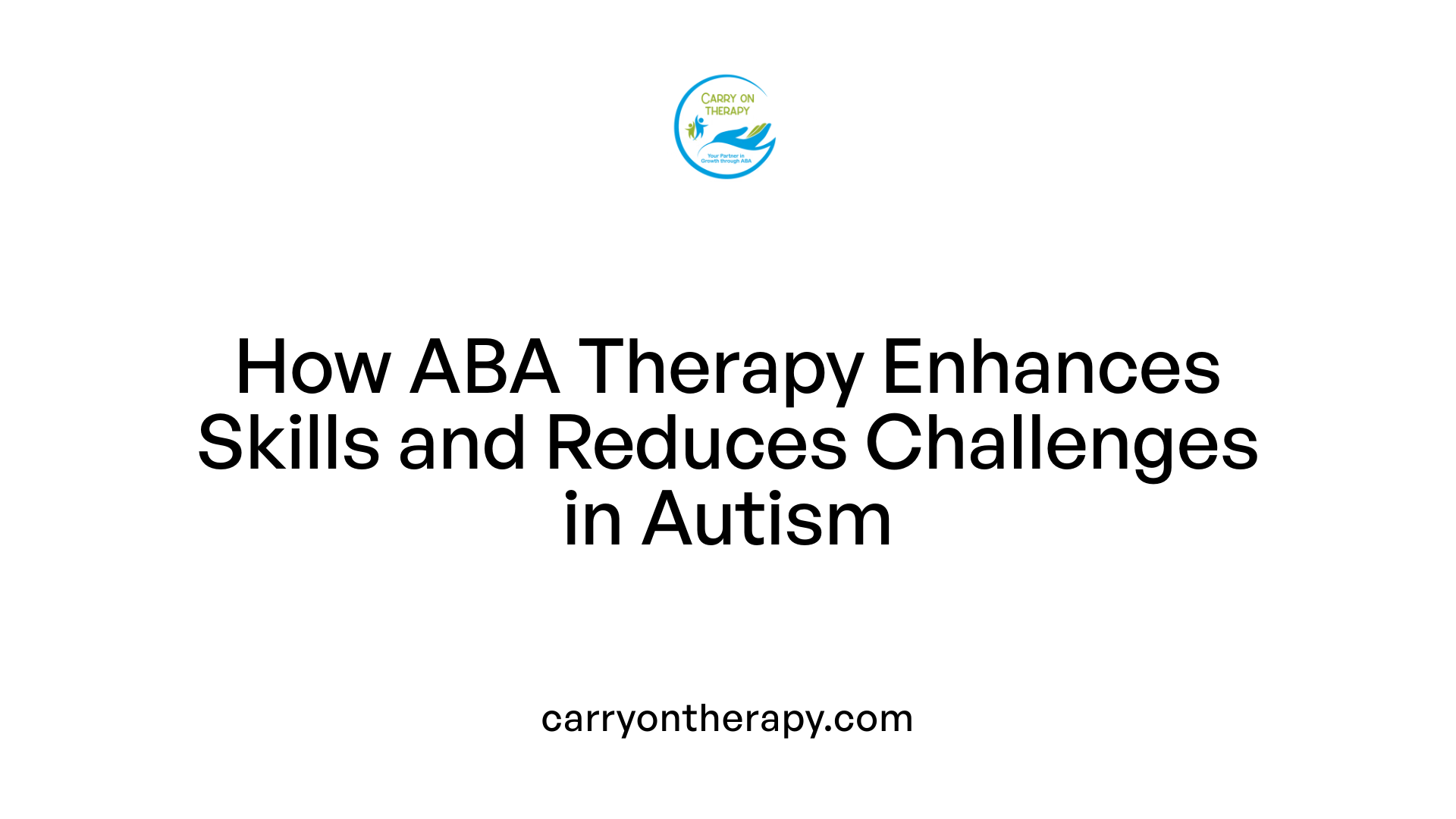
How does ABA therapy benefit individuals with autism?
ABA (Applied Behavior Analysis) therapy offers a structured, evidence-based approach to support individuals with autism by focusing on behavior analysis and intervention. Through detailed observation and data collection, therapists identify behaviors to encourage or modify, using techniques such as positive reinforcement and prompt fading.
This targeted approach leads to improvements in essential skills like communication, social interaction, and daily living activities while also reducing challenging behaviors. Early and intensive ABA programs are particularly effective, often helping children gain better language abilities, stronger attention spans, enhanced memory, and improved social skills.
Behavior analysis and intervention
At its core, ABA therapy scientifically examines behavior triggers and consequences, allowing personalized interventions that promote helpful behaviors. By understanding why a behavior occurs, therapists can design strategies to replace inappropriate actions with positive alternatives, fostering skill growth and emotional regulation.
Skill improvement
ABA therapy supports development across multiple domains, including language, cognitive abilities, self-care, and social competencies. Consistent practice and reinforcement enable individuals to build independence and adapt to everyday challenges.
Flexibility of therapy settings
ABA programs are versatile and can be customized to different environments such as home, school, or community settings. This flexibility ensures that interventions are relevant and accessible, maximizing opportunities for learning and generalizing new skills.
Through these benefits, ABA therapy plays a vital role in improving the quality of life for individuals with autism, helping them achieve greater independence and social integration.
Professionals Delivering ABA Therapy

Who typically provides ABA therapy?
ABA therapy is typically delivered by a range of qualified professionals trained in behavior analysis. This group includes Board Certified Behavior Analysts (BCBAs), who often lead treatment planning and supervision. Board Certified Assistant Behavior Analysts (BCaBAs) support BCBAs by implementing program components under their direction. Registered Behavior Therapists (RBTs) work closely with clients to carry out daily therapy tasks.
Settings of therapy delivery
ABA therapy can take place in various environments tailored to client needs. Common settings include clinical centers specializing in behavior analysis, educational institutions, and clients' homes. Each setting allows therapists to create individualized treatment plans and apply interventions in natural contexts, improving generalization of skills.
Role of multidisciplinary teams
ABA therapy often operates within a multidisciplinary framework to address complex developmental needs. Alongside behavior analysts, other professionals such as neurologists, psychiatrists, psychologists, occupational therapists, and speech-language pathologists may be involved. This team collaborates to conduct comprehensive assessments, ensure medical necessity, and integrate interventions. The combined expertise fosters holistic support for individuals receiving ABA therapy.
Core Components of Effective ABA Therapy

What are the key components involved in delivering ABA therapy?
Effective Applied Behavior Analysis (ABA) therapy hinges on a structured process, starting with a thorough assessment conducted by qualified professionals like Board Certified Behavior Analysts (BCBAs). This initial evaluation identifies specific behavioral challenges and strengths in the individual.
Following assessment, a personalized intervention plan is developed. This plan is grounded in scientific principles and designed to target the individual's unique needs. It incorporates various behavior intervention techniques such as discrete trial training, prompting, and reinforcement strategies aimed at encouraging positive behaviors and reducing maladaptive ones.
Consistent data collection and analysis play a crucial role throughout therapy. By systematically tracking progress, therapists can evaluate the effectiveness of interventions and make informed adjustments to optimize outcomes.
An essential element of ABA therapy is teaching functional skills across different environments to promote generalization. Caregiver and parent involvement is also vital, as their training ensures continuity and consistency of strategies outside of clinical settings.
In summary, effective ABA therapy integrates the following core components:
- Comprehensive behavioral assessment by trained specialists
- Development and implementation of personalized, evidence-based intervention plans
- Continuous data collection and performance review
- Focus on functional skill acquisition across settings
- Active caregiver training and involvement
This structured approach ensures that therapy is scientific, individualized, and collaborative, ultimately fostering meaningful behavior change and skill development.
The Role of Sensory Tables in Autism Therapy
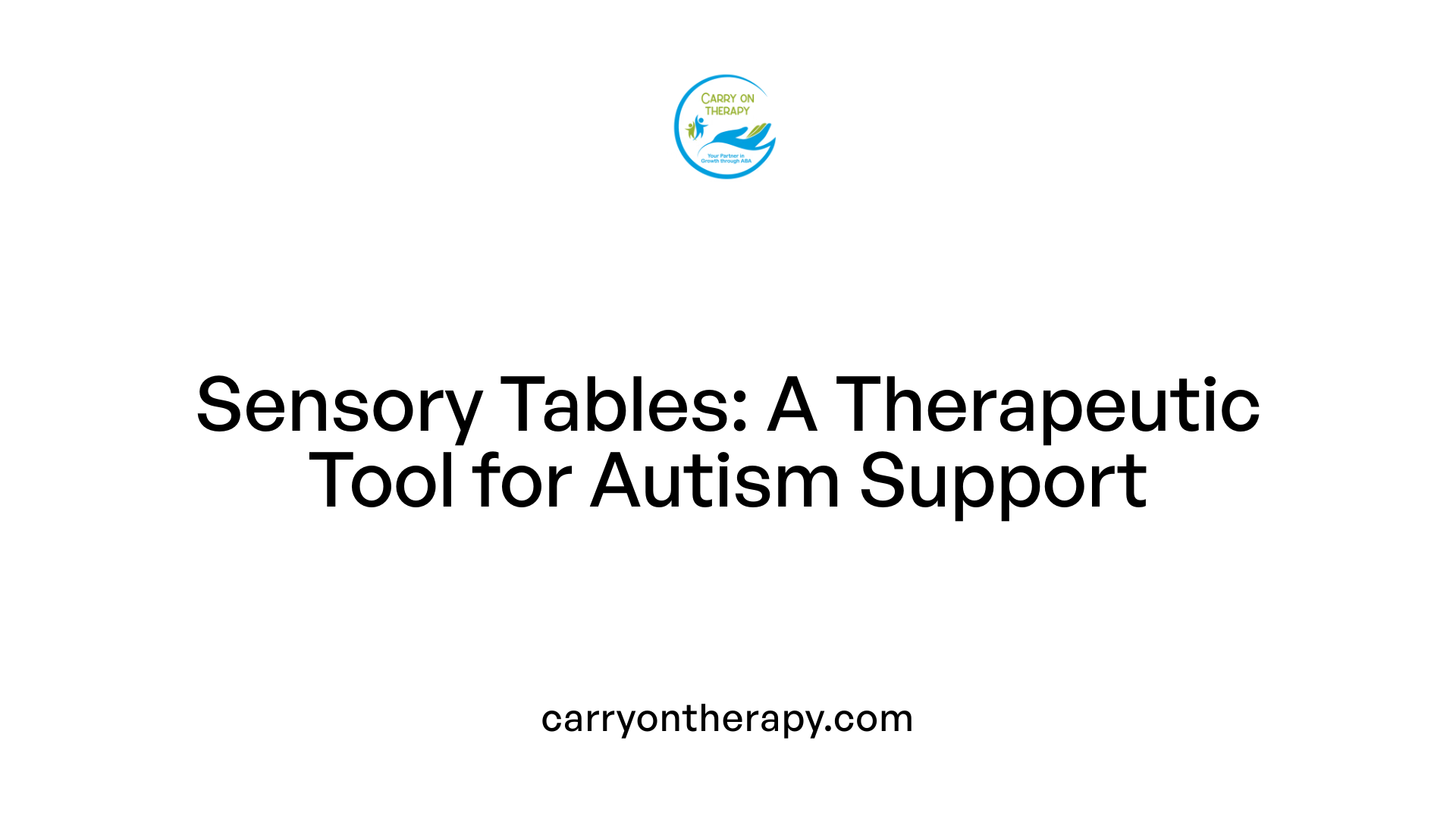
What are sensory tables and what is their purpose?
Sensory tables, also known as sensory bins, are containers filled with materials designed to engage multiple senses simultaneously. Commonly used in early childhood education and therapeutic settings, these tables provide children with hands-on opportunities to explore textures, colors, and objects. For children with autism, sensory tables serve as controlled environments where they can safely experience sensory input tailored to their unique needs.
How do sensory tables benefit children through multi-sensory stimulation?
Sensory tables stimulate various senses, including touch, sight, and sometimes smell, through materials with different textures, shapes, and colors. This multi-sensory engagement supports the development of fine motor skills and fosters cognitive growth by introducing basic mathematical and scientific concepts. Additionally, interacting with sensory tables encourages creativity and social interaction, making them powerful tools to enhance overall developmental progress.
How do sensory tables address sensory processing difficulties in children with autism?
Children with autism often face challenges in sensory processing, which can lead to feelings of overwhelm or under-stimulation. Sensory tables provide a calming and focused way to manage these sensory needs by offering predictable and controllable stimuli. Tailoring the content to individual preferences helps reduce anxiety and distracts from overwhelming environmental factors. This regulated exposure supports sensory processing development and can improve concentration, emotional regulation, and engagement in learning activities.
How Sensory Tables Support Sensory Processing
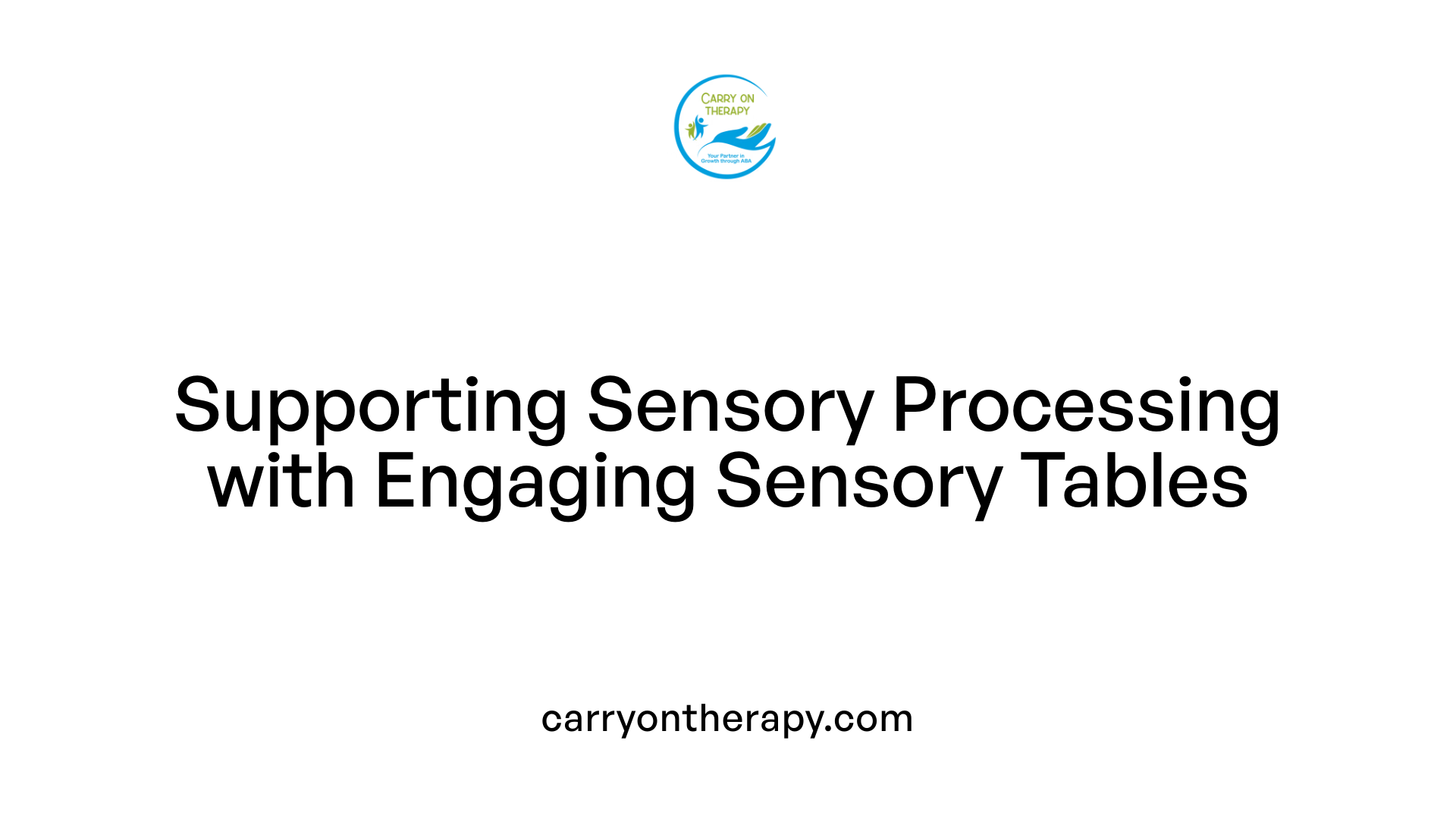
What is Controlled Sensory Input and Why is it Important?
Sensory tables offer a carefully controlled sensory environment that is particularly helpful for children on the autism spectrum. They provide sensory input in a manageable way, helping these children regulate their responses to different stimuli. This controlled input allows for gradual and comfortable exploration, making it easier for children with sensory processing difficulties to engage without feeling overwhelmed.
How Do Stimulating Textures and Colors Help?
Sensory tables are filled with materials that offer a variety of textures and vibrant colors. These sensory elements are not only attractive but also essential for sensory exploration. Textured fillers like sand, pebbles, or playdough provide tactile experiences that help the nervous system interpret touch and pressure. Bright colors enhance visual stimulation, which can prompt curiosity and sustained interaction.
How Do Sensory Tables Support Sensory Processing Development?
By engaging multiple senses—touch, sight, sometimes even sound and smell—sensory tables promote the development of sensory integration skills. This engagement helps children learn to process sensory information more effectively. Through regular play with sensory tables, children refine their fine motor skills and improve concentration, while also building an understanding of various materials and concepts in a sensory-friendly way.
Overall, sensory tables act as meaningful tools in fostering the sensory processing abilities of children with autism, enabling them to experience the world in ways that support their comfort and growth.
Calming Effects of Sensory Tables for Autistic Children

How do sensory tables help with focus and distraction from overwhelming stimuli?
Sensory tables provide a controlled environment filled with tactile and visual stimuli, which helps children with autism channel their attention away from overwhelming external inputs. By engaging with the textured materials and themed objects, children can maintain focus on the sensory experience, reducing anxiety caused by chaotic surroundings.
How do sensory tables support emotional regulation?
The tactile exploration of materials in sensory tables allows autistic children to manage their sensory processing needs effectively. This regulation of sensory input can lessen emotional distress, offering a soothing outlet that promotes calmness. The repetitive and predictable nature of manipulating sensory materials helps children self-regulate moods and emotions.
What are the therapeutic relaxation benefits of sensory tables?
Sensory tables foster therapeutic relaxation by combining multisensory stimulation with play. The varied textures, colors, and manipulation involved invite mindfulness and calm engagement. This combination can lower stress levels and provide a peaceful break from overstimulation, benefiting children’s emotional and mental well-being.
Designing a DIY Sensory Table: Container and Safety Considerations
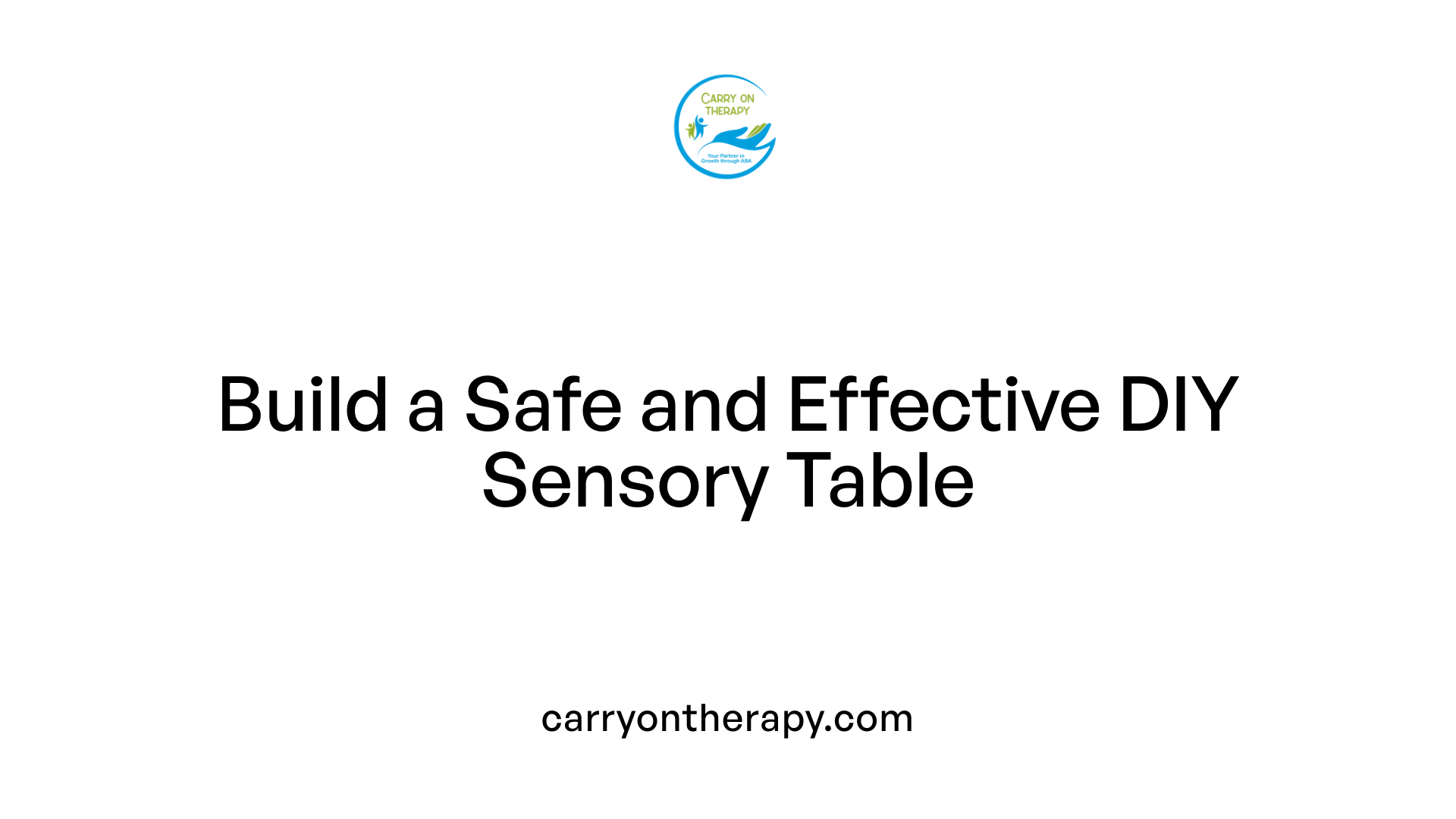
Choosing the Appropriate Container
When setting up a DIY sensory table, selecting the right container is crucial. The container should be sturdy and large enough to hold various sensory materials while allowing children to explore comfortably. Common options include plastic tubs or shallow storage bins with smooth edges to prevent injuries. The height should be accessible, promoting ease of use for children of different ages and abilities.
Ensuring Safety and Hygiene
Safety is a top priority when designing sensory bins. Use non-toxic fillers and avoid small items that could pose choking hazards, especially for children with sensory disorders like pica. Regular cleaning and disinfecting of containers and materials prevent the buildup of germs. Checking contents for sharp edges and removing any broken pieces keeps the play environment safe. Tailoring the sensory materials to each child's sensitivities also helps avoid overstimulation or discomfort.
Accessibility and Ease of Use
A well-designed sensory table should be easily reachable and adaptable for children with different needs. Consider placing the table at a height suitable for seated or standing play. Materials should be organized within reach to encourage independent exploration. Labeling containers or using themed sets can help children understand and engage with the sensory activities more effectively. These considerations make the sensory experience inviting and manageable for all participants.
Selecting Fillers for DIY Sensory Tables
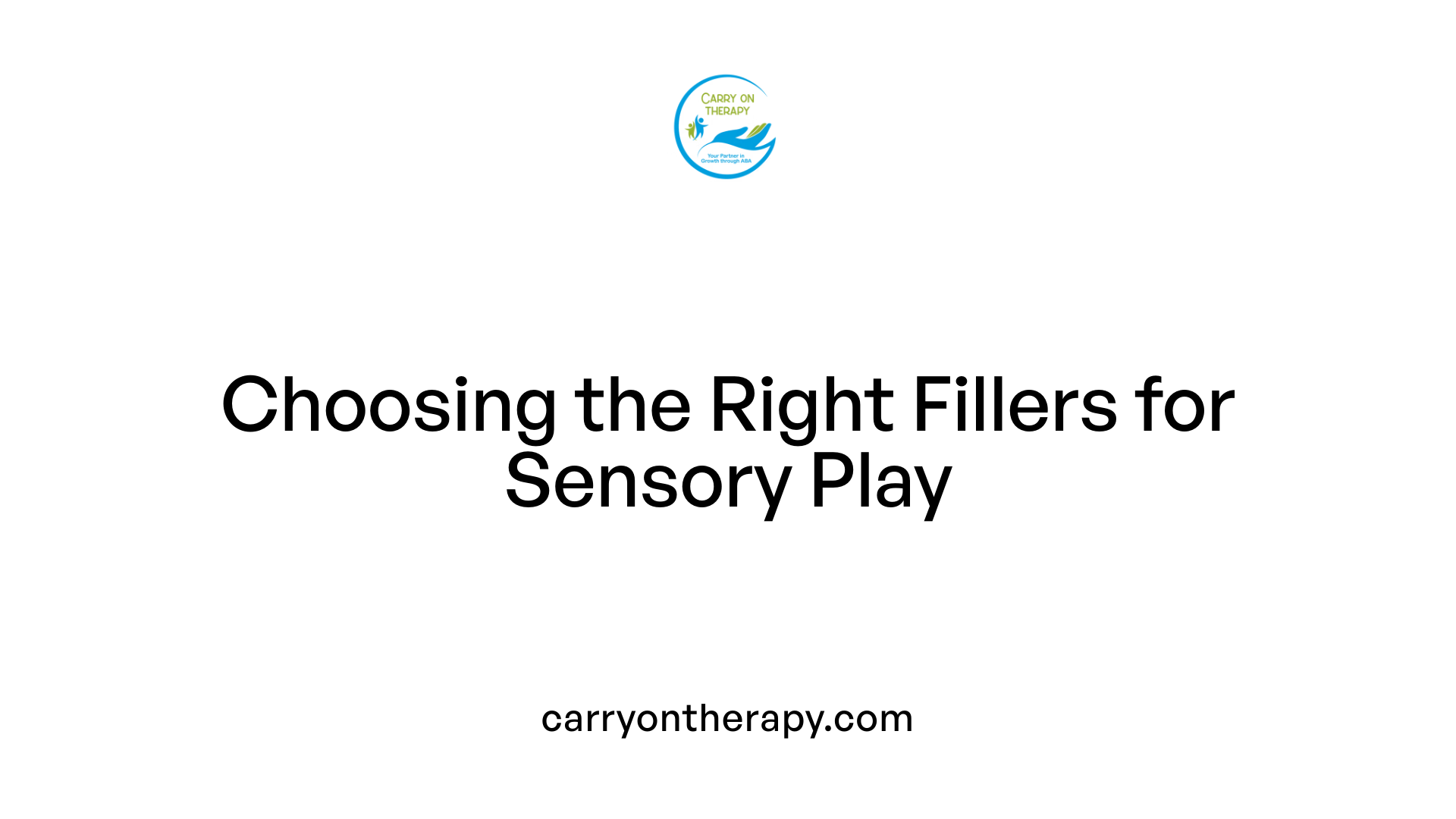
Varied textures and materials
When assembling fillers for DIY sensory tables, it is important to include a range of textures and materials. This variety stimulates multiple senses, encouraging children to explore through touch, sight, and sometimes sound. Common fillers can range from dry items like pasta, pebbles, and sand to moist substances such as homemade playdough. Including items like bubble wrap can also add an element of tactile fun with popping sensations, enhancing sensory engagement.
Considerations for sensory sensitivities or disorders
Children with sensory sensitivities or sensory disorders, such as autism or pica, require tailored sensory bin contents. Safety is paramount, so fillers should be non-toxic and free from choking hazards. It is essential to observe individual preferences and sensitivities; some children may be overwhelmed by certain textures or strongly dislike wet materials. Selecting fillers thoughtfully helps create a calming, focused environment that supports sensory processing without causing distress.
Choices for tactile stimulation
Effective tactile stimulation comes from fillers offering different consistencies and engagement opportunities. For example, smooth, round pebbles provide a cool, hard texture, while soft homemade playdough offers malleability that supports fine motor skill development. Threading beads, stacking bricks, and sorting objects like colored pebbles encourage both creativity and cognitive development through hands-on interaction. Incorporating such diverse fillers ensures rich, therapeutic sensory experiences that cater specifically to the needs of children with sensory processing challenges.
Incorporating Thematic Toys and Objects in Sensory Tables
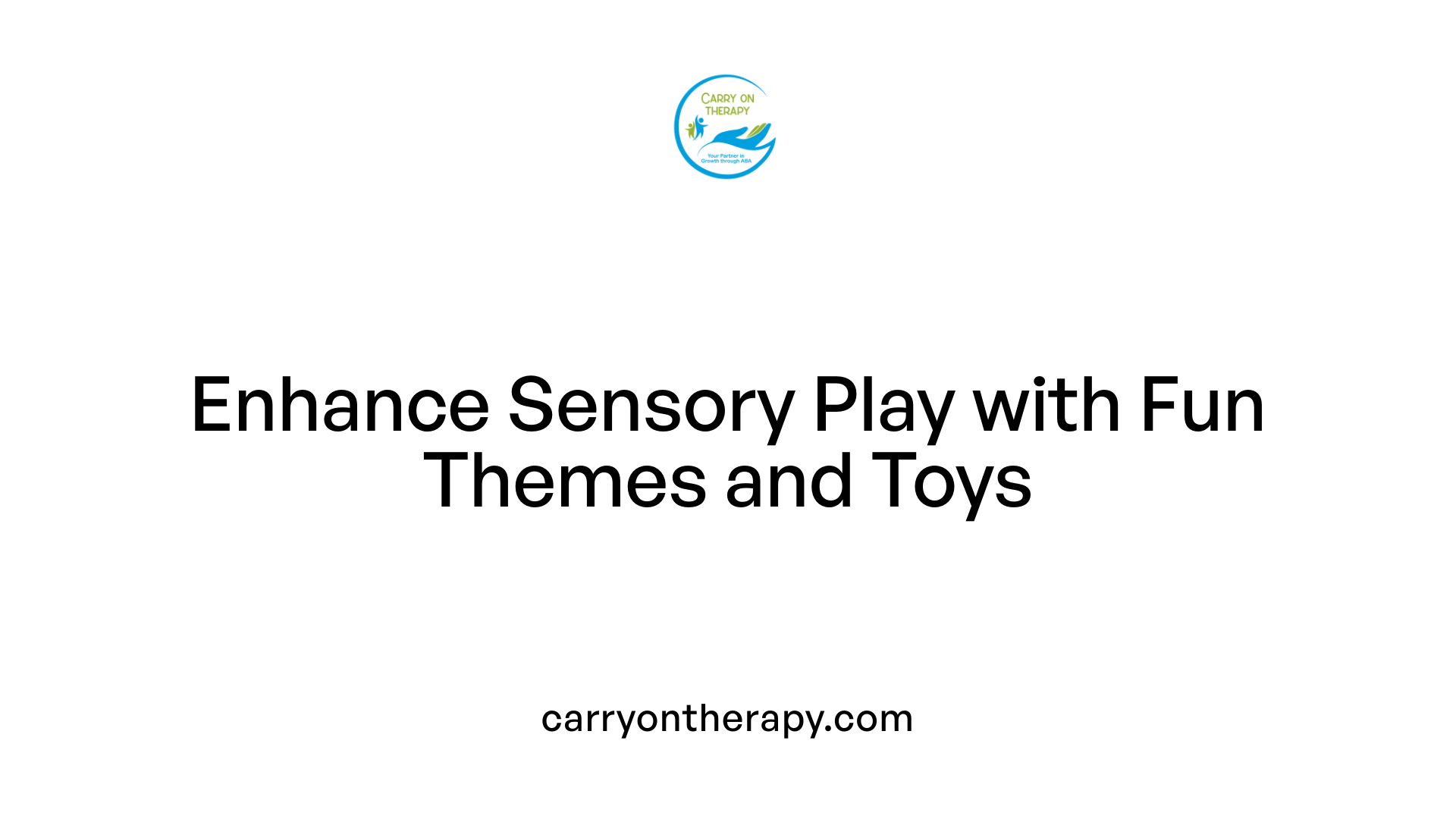
Types of themes such as dinosaurs and animals
Sensory bins often include thematic toys and objects that align with popular interests like dinosaurs, animals, and construction. These themes not only make sensory play more enjoyable but also help children connect sensory experiences with recognizable concepts from their everyday lives or stories.
Enhancing engagement and learning
Using themed sensory tables boosts children's engagement by capturing their curiosity and encouraging exploration. The incorporation of familiar items stimulates imagination and encourages role-playing activities, which facilitates social interaction and language development. Themes can also support learning by introducing children to concepts like habitat, shapes, or numbers linked to the chosen theme.
Supporting fine motor and cognitive skills
The objects and toys within sensory tables offer varied textures and sizes that promote the development of fine motor skills, such as grasping, pinching, and manipulating. For example, small animal figures require precise hand movements to sort or position, aiding hand-eye coordination. Additionally, themed materials can foster cognitive skills by encouraging sorting, categorization, and problem-solving related to the theme. Thus, thematic sensory bins serve as versatile tools to support both sensory processing and educational development.
Pre-made Sensory Bin Kits: Pros and Cons
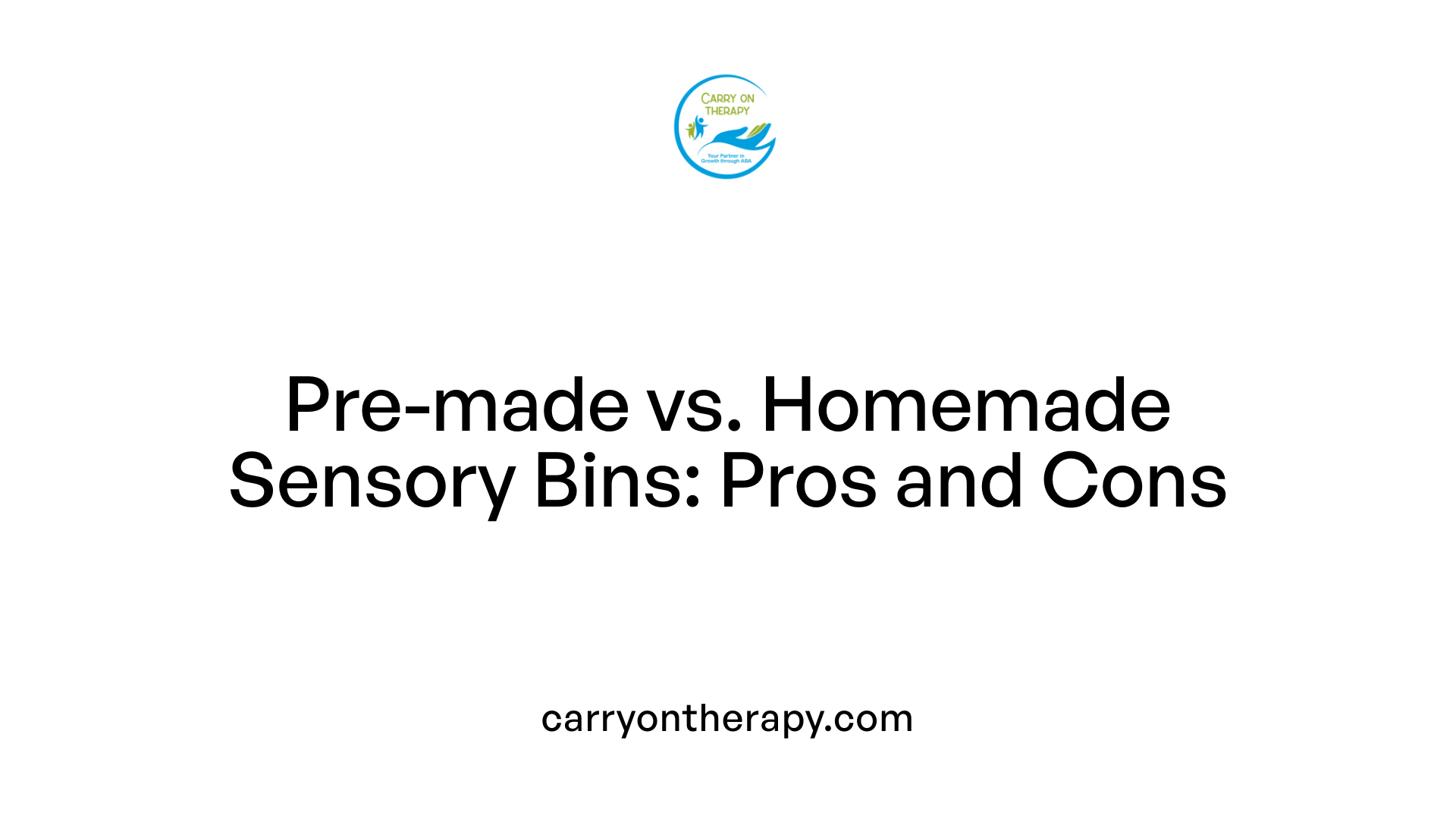
Convenience and Variety
Pre-made sensory bin kits offer a convenient option for parents and educators by providing all necessary materials in one package. These kits often come with engaging themes such as dinosaurs, construction, or animals, which can captivate children's attention and enhance their interest during activities. The variety of themes available caters to diverse preferences, making it easier to find a kit that suits a child's unique sensory needs.
Comparison with Homemade Options
While pre-made kits are ready to use and save preparation time, homemade sensory bins provide a personalized approach. Creating bins at home allows caregivers to choose specific fillers and toys tailored to a child's sensory sensitivities or preferences. Homemade bins can also incorporate safe materials that accommodate conditions like pica, ensuring a safer sensory play environment.
Customization Potential
Although pre-made kits are designed for broad appeal, they might require some modification to fully meet an individual child's needs. Parents and therapists often supplement these kits with additional sensory items to customize the experience. This flexibility ensures that sensory input is controlled and beneficial, especially for children with autism who benefit from tailored sensory stimulation to support processing and engagement.
Homemade Sensory Activities to Supplement Sensory Tables
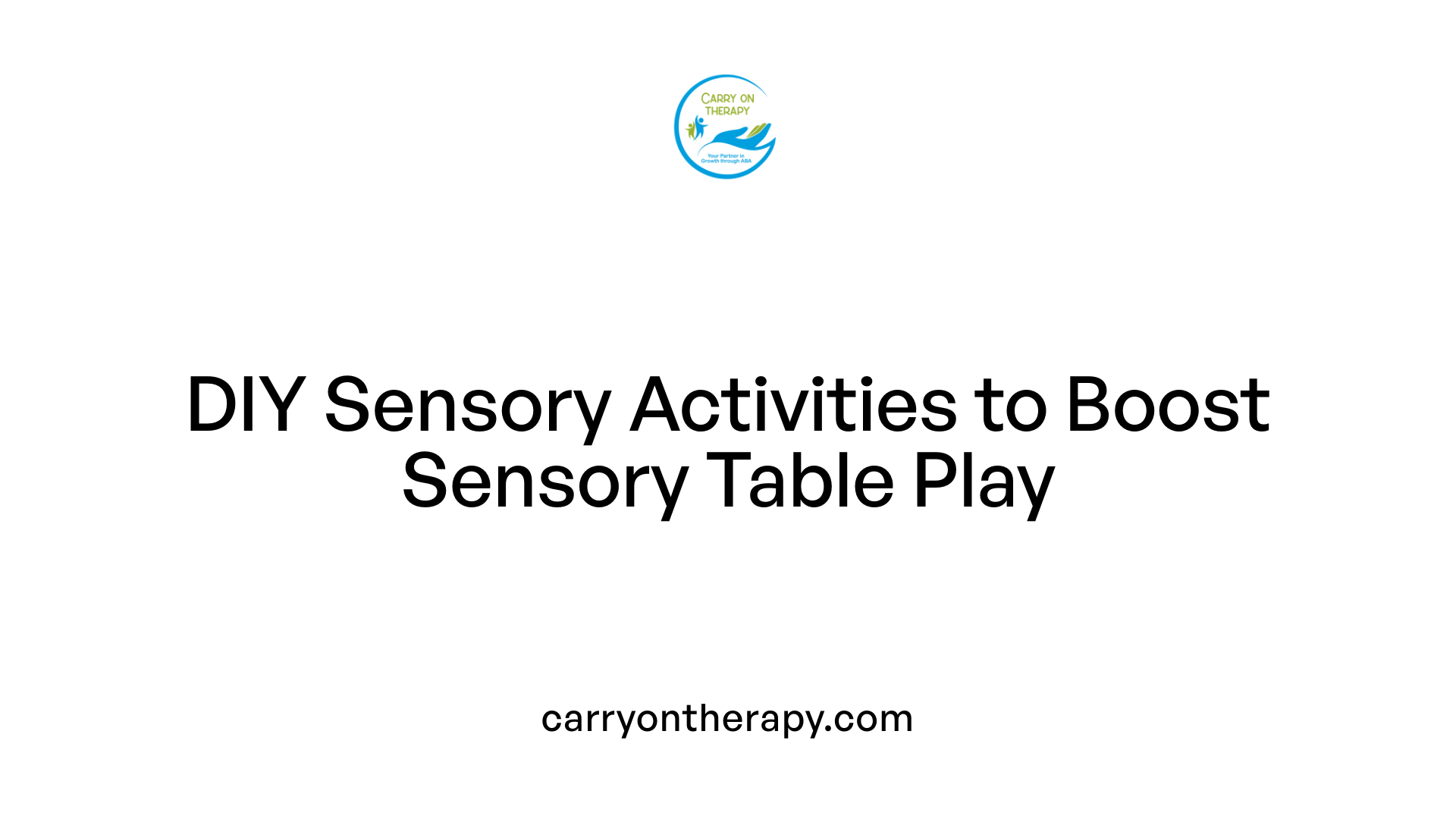
How does playdough support tactile and cognitive development?
Homemade playdough offers children a rich tactile sensory experience that engages their sense of touch. Manipulating playdough strengthens fine motor skills as children knead, roll, and shape the dough. Beyond motor benefits, these activities stimulate cognitive development by encouraging creativity and problem-solving. Additionally, playdough exercises provide early detection opportunities for motor skill delays, allowing caregivers and therapists to observe and assist as needed.
What are the benefits of crafting pasta necklaces for fine motor skills?
Crafting pasta necklaces is a fun and creative sensory activity that enhances fine motor skills, especially dexterity and hand-eye coordination. Threading pasta pieces onto string or yarn requires children to focus, make decisions about the pattern or color, and practice precise finger movements. This activity also fosters creativity and is sometimes used in pediatric occupational therapy to support children with developmental delays. By engaging in pasta necklace crafting, children develop concentration and sequencing skills.
How does finger painting promote creativity and skill development?
Finger painting is an engaging, tactile activity that improves fine motor skills and hand-eye coordination by encouraging controlled finger and hand movements. It nurtures creativity as children experiment with colors, shapes, and textures on paper or other surfaces. Finger painting also provides calming and therapeutic benefits, making it a useful tool for reducing anxiety and aiding emotional expression. Furthermore, it can support social skills development when done in group settings, encouraging interaction and collaboration.
Mini Sand Gardens for Mindful and Tactile Play

How Do Mini Sand Gardens Provide a Calming Sensory Experience?
Mini sand gardens offer a soothing tactile environment that can help children, especially those with autism, find calm in a busy world. The gentle sensation of sand slipping through fingers provides natural sensory input that distracts from overwhelming stimuli and reduces stress.
How Do Mini Sand Gardens Help Develop Fine Motor Skills?
Playing with mini sand gardens involves actions like scooping, sifting, and shaping sand, which require precise hand and finger movements. These activities build fine motor skills that are essential for everyday tasks such as writing and buttoning clothes.
In What Ways Do Mini Sand Gardens Encourage Focus and Patience?
Engaging in sand garden play is an exercise in mindfulness. Children must concentrate to create patterns or small sculptures, which encourages patience and sustained attention. This type of focused play is beneficial for cognitive development and emotional regulation.
Sorting Pebbles: Developing Cognitive and Sensory Skills
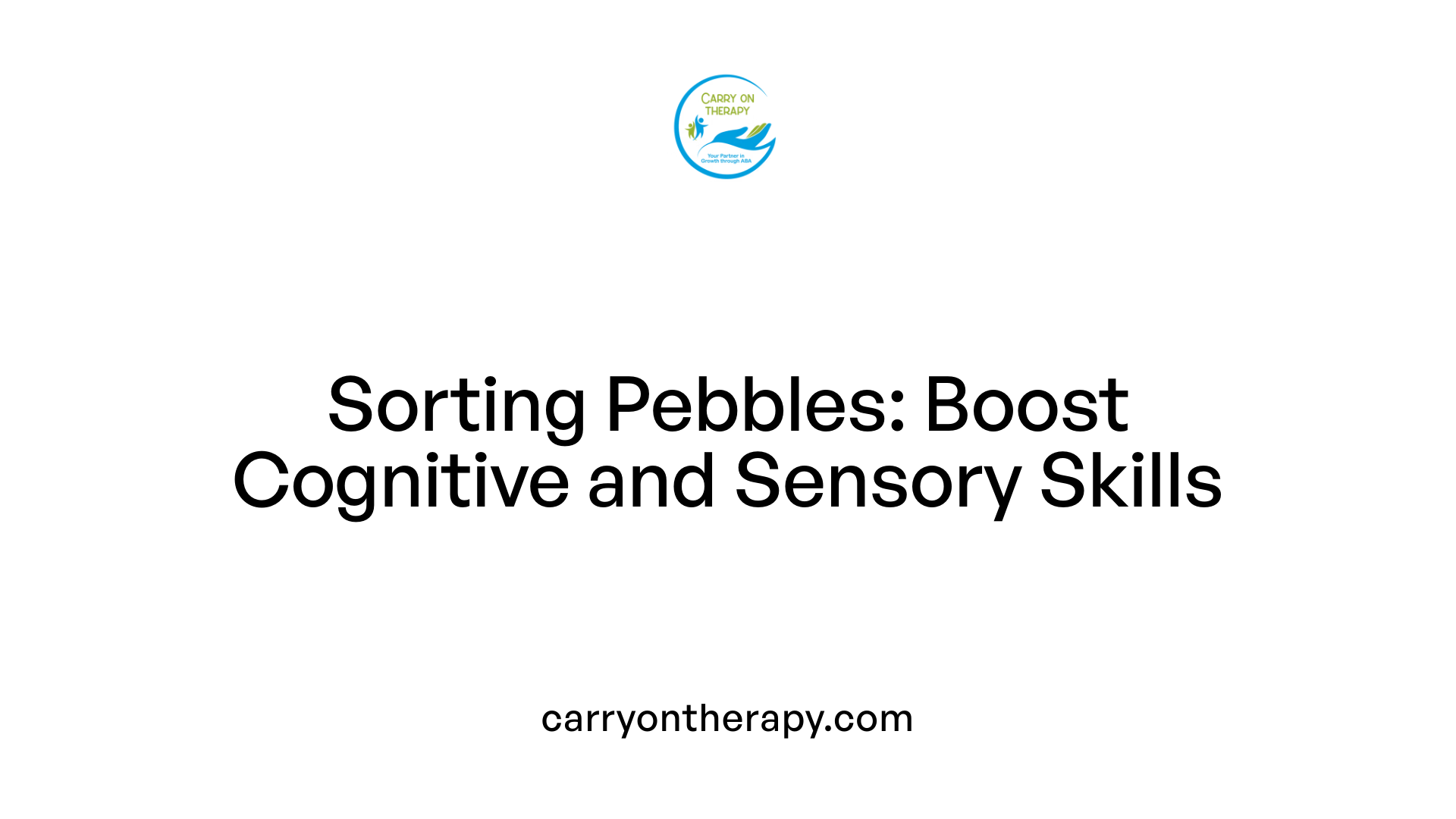
Enhancing Categorization and Organization
Sorting pebbles by attributes such as color, size, or shape is an engaging activity that encourages cognitive development. It invites children to recognize differences and similarities, boosting their ability to categorize and organize objects efficiently.
Fine Motor Skill Development
Handling small pebbles enhances fine motor skills by requiring children to pick up, hold, and arrange them carefully. This precise manipulation supports the growth of hand-eye coordination and dexterity, which are fundamental for everyday tasks.
Exploration Through Different Attributes
This activity also promotes sensory exploration, as children experience varied textures and visual stimuli. Investigating pebbles by their physical qualities fosters attention to detail and sensory processing, especially beneficial for children with autism who benefit from controlled sensory input.
Interactive Watering of Flowers: Sensory and Responsibility

How does interactive watering of flowers enhance fine motor skills?
Interactive watering of flowers requires children to practice precise hand movements, which enhances their fine motor skills. Handling small watering cans or spray bottles strengthens hand muscles and improves hand-eye coordination. These activities also promote manual dexterity, which is crucial for tasks like writing, buttoning clothes, and using utensils.
How is sensory play linked to nature through watering flowers?
Watering flowers is a sensory-rich experience that connects children directly to nature. Through the tactile sensation of water, the visual stimuli of vibrant flowers, and the earthy smells of soil, children engage multiple senses simultaneously. This connection fosters curiosity about the natural world and nurtures a deeper appreciation for living plants.
What are the calming and environmental awareness benefits?
Engaging in watering flowers offers a calming effect that helps children focus and reduces anxiety, particularly beneficial for children with sensory processing challenges. The rhythmic nature of watering plants encourages mindfulness and patience. Additionally, this activity promotes environmental awareness by teaching children responsibility and the importance of caring for living things, cultivating sensitivity to their surroundings.
The Therapeutic Benefits of Popping Bubble Wrap

How Does Popping Bubble Wrap Provide Multi-Sensory Stimulation?
Popping bubble wrap is a simple yet effective sensory activity that engages multiple senses simultaneously. The tactile sensation of pressing the bubbles, the audible 'pop' sound, and the visual feedback of bubbles popping combine to create a rich sensory experience. This multi-sensory input can be especially beneficial for children who need varied sensory stimulation to help process sensory information.
How Does Popping Bubble Wrap Aid Stress Relief and Emotional Regulation?
The repetitive action of popping bubbles offers an enjoyable and calming outlet. This activity can serve as a distraction from overwhelming stimuli, helping children, particularly those with autism, to manage stress and regulate their emotions. The satisfying sensory input helps in focusing attention and can reduce feelings of anxiety.
In What Ways Does Popping Bubble Wrap Enhance Fine Motor Control?
Engaging in popping bubble wrap requires precise finger movements and hand coordination. This repetitive finger pressing strengthens fine motor skills and promotes better hand-eye coordination. Improved fine motor control is essential for daily tasks and overall developmental progress.
Overall, popping bubble wrap is a cost-effective and accessible therapeutic tool that supports sensory processing, emotional well-being, and motor development, making it an excellent addition to sensory bins or therapy sessions.
Threading Beads on Pipe Cleaners: Coordination and Creativity

How Does Threading Beads Improve Hand-Eye Coordination?
Threading beads onto pipe cleaners requires precise hand movements combined with visual focus. This activity engages children's hand-eye coordination by encouraging them to align small beads correctly for threading, fine-tuning their motor skills.
In What Ways Does This Activity Support Creativity and Concentration?
By selecting bead colors, patterns, and arrangements, children tap into their creative skills. The process demands sustained attention and concentration, which helps develop their ability to focus on detailed tasks.
How Is Threading Beads Used in Sensory Integration Therapy?
In sensory integration therapy, threading beads serves as a tactile and visual sensory input that promotes sensory processing. It helps children, especially those with developmental delays or autism, to improve fine motor control and sensory regulation in a structured, engaging way.
Stacking Bricks: Spatial Awareness and Problem-solving
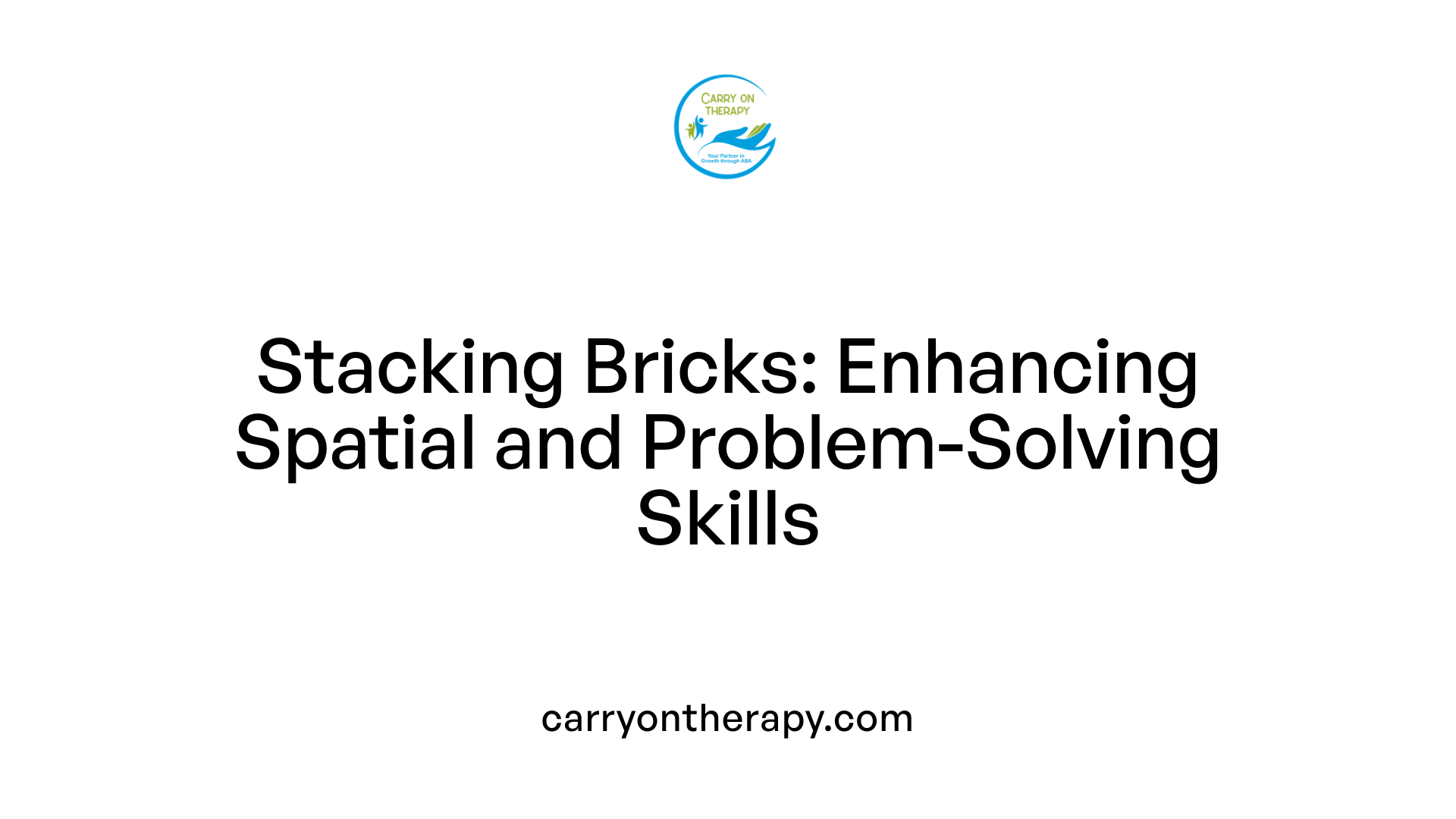
Developing hand-eye coordination
Stacking bricks is an engaging activity that significantly boosts hand-eye coordination in children. As they carefully place one brick atop another, they learn to judge distances, align objects accurately, and improve dexterity. This precise motor skill is essential for everyday tasks and further fine motor development.
Encouraging creativity and balance concepts
Beyond coordination, stacking bricks opens a window to creative expression. Children experiment with designs, creating towers, bridges, or patterns. This process fosters their imagination while introducing foundational ideas of balance and symmetry. Understanding how different configurations affect stability encourages critical thinking and planning.
Cognitive skill building
The cognitive benefits of stacking bricks are extensive. Children develop problem-solving skills as they address challenges like preventing a tower from toppling. Spatial awareness improves as they visualize how bricks fit together in three dimensions. This hands-on learning supports comprehension of scientific and mathematical concepts in a fun, accessible way.
By integrating stacking bricks into play, educators and therapists can nurture multiple developmental areas simultaneously. This activity serves as an excellent tool, especially for children with sensory processing needs, supporting growth through exploration and tactile interaction.
Integrating Sensory Table Activities with ABA Therapy

How Can Sensory Play Enhance ABA Intervention?
Sensory play, including activities using sensory bins or tables, offers a hands-on approach to ABA (Applied Behavior Analysis) therapy. By engaging multiple senses, these activities provide controlled sensory input that helps children with autism manage sensory processing challenges. The tactile and visual stimulation from materials like sand, beads, or textured objects makes learning more engaging and can increase a child's focus during ABA sessions.
How Does Sensory Play Reinforce Targeted Behaviors?
Using sensory tables allows therapists to embed ABA-targeted behaviors into play. For example, sorting pebbles by color or shape can reinforce categorization and organizational skills, while stacking bricks can support problem-solving and fine motor coordination. The structured yet flexible nature of sensory play helps children practice specific behaviors repeatedly, encouraging skill acquisition in a naturalistic setting.
How Does Sensory Play Support Individualized Therapy Goals?
Sensory bins and related activities can be tailored to each child's unique preferences and sensory sensitivities, ensuring comfort and effectiveness. Themes like animals or construction motivate engagement and can support specific goals, such as improving social interaction or communication. Additionally, interactive tasks like watering flowers promote responsibility and environmental awareness, complementing individualized ABA objectives. Crafting activities, like pasta necklaces or finger painting, also foster creativity, decision-making, and fine motor skills crucial for development.
Integrating sensory table activities into ABA therapy not only enriches the learning experience but also provides calming and therapeutic benefits. This multi-sensory approach helps children with autism progress toward individualized goals while making therapy sessions enjoyable and meaningful.
Tailoring Sensory Tables to Individual Needs
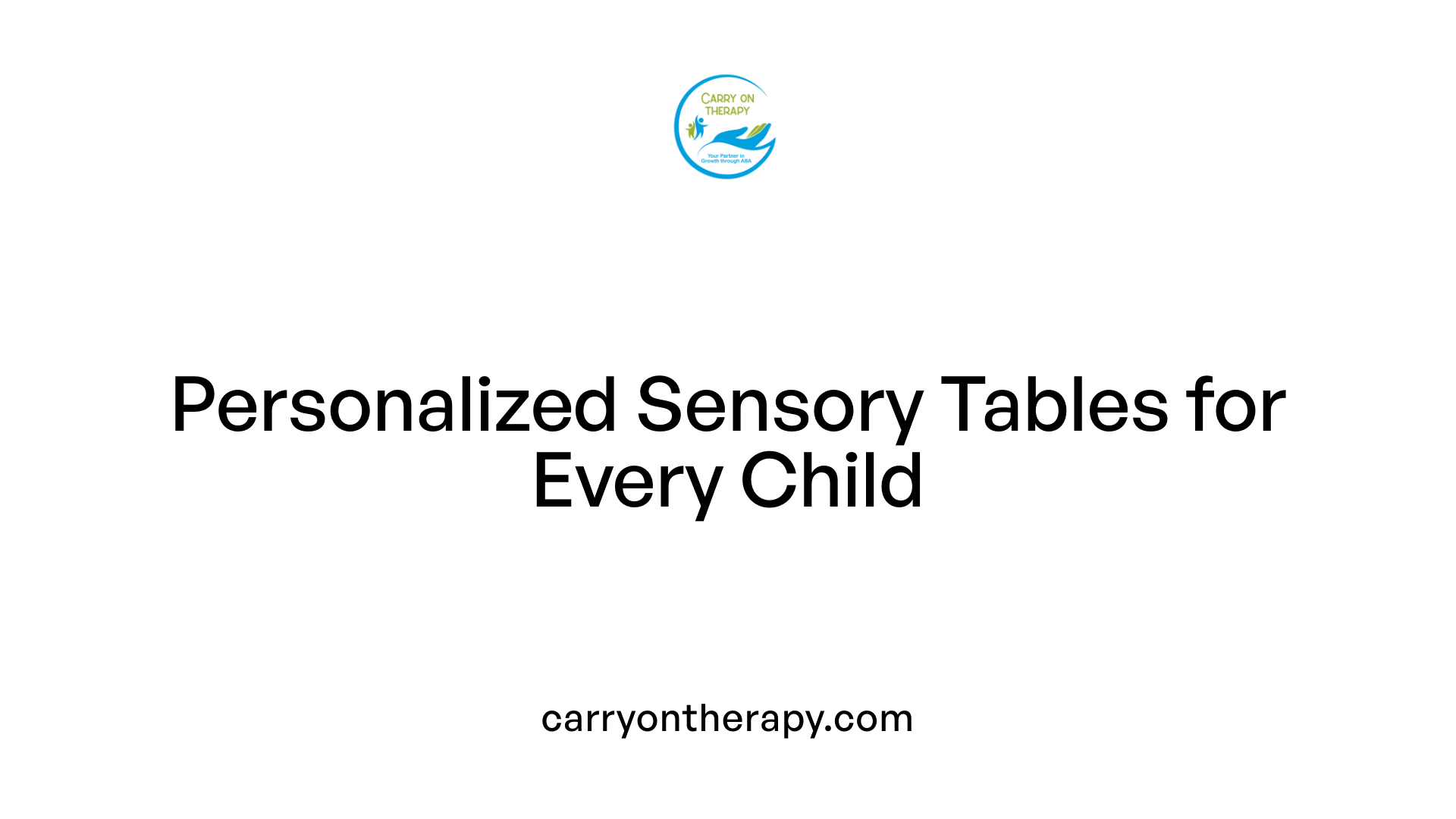
Customizing Content Based on Preferences
Sensory tables are most effective when their materials and themes align with the child's individual interests and preferences. This personalization encourages engagement and makes activities more meaningful. For example, themes like dinosaurs, construction, or animals not only capture attention but also support skill development through familiar and appealing content.
Adjusting for Sensory Sensitivities and Disorders
Children with autism or sensory processing disorders often have unique sensory sensitivities that require careful adjustment of sensory bin contents. For some, certain textures or materials might be overwhelming or distressing. In such cases, avoiding triggering fillers and selecting safe, preferred textures is vital. Additionally, for children with conditions like pica, who might ingest non-food items, it is important to tailor materials to be non-toxic and closely supervised to ensure safety.
Ensuring Positive and Safe Engagement
Safety is paramount when setting up sensory tables. Choosing appropriate containers, non-toxic fillers, and age-appropriate objects helps prevent accidents or ingestion. Supervision during use further guarantees positive, safe experiences. This thoughtful approach to customization balances stimulation with comfort, promoting confidence and calmness in children as they interact with their sensory environment.
Encouraging Social Skills Through Group Sensory Play

Opportunities for interaction and cooperation
Group sensory play offers children a natural setting to interact and cooperate. When children engage in activities like sorting pebbles by color or building with stacking bricks within a sensory bin, they learn to share materials and space. These shared experiences encourage cooperative play, fostering teamwork as they negotiate roles and help each other.
Developing communication skills
Sensory play activities also promote the development of communication skills. As children describe textures, colors, or the process of an activity such as threading beads onto pipe cleaners, they practice vocabulary and expressive language. Collaborating on projects like crafting pasta necklaces inspires conversation and instruction-sharing, enhancing verbal and non-verbal communication.
Building shared attention and turn-taking
In group settings, children develop shared attention by focusing on common sensory play goals. Turn-taking naturally emerges during activities like popping bubble wrap or interactive watering of flowers, teaching patience and social cues. These structured interactions are especially beneficial for children with autism, helping them navigate social dynamics in a supportive environment.
Maintaining and Refreshing Sensory Table Materials
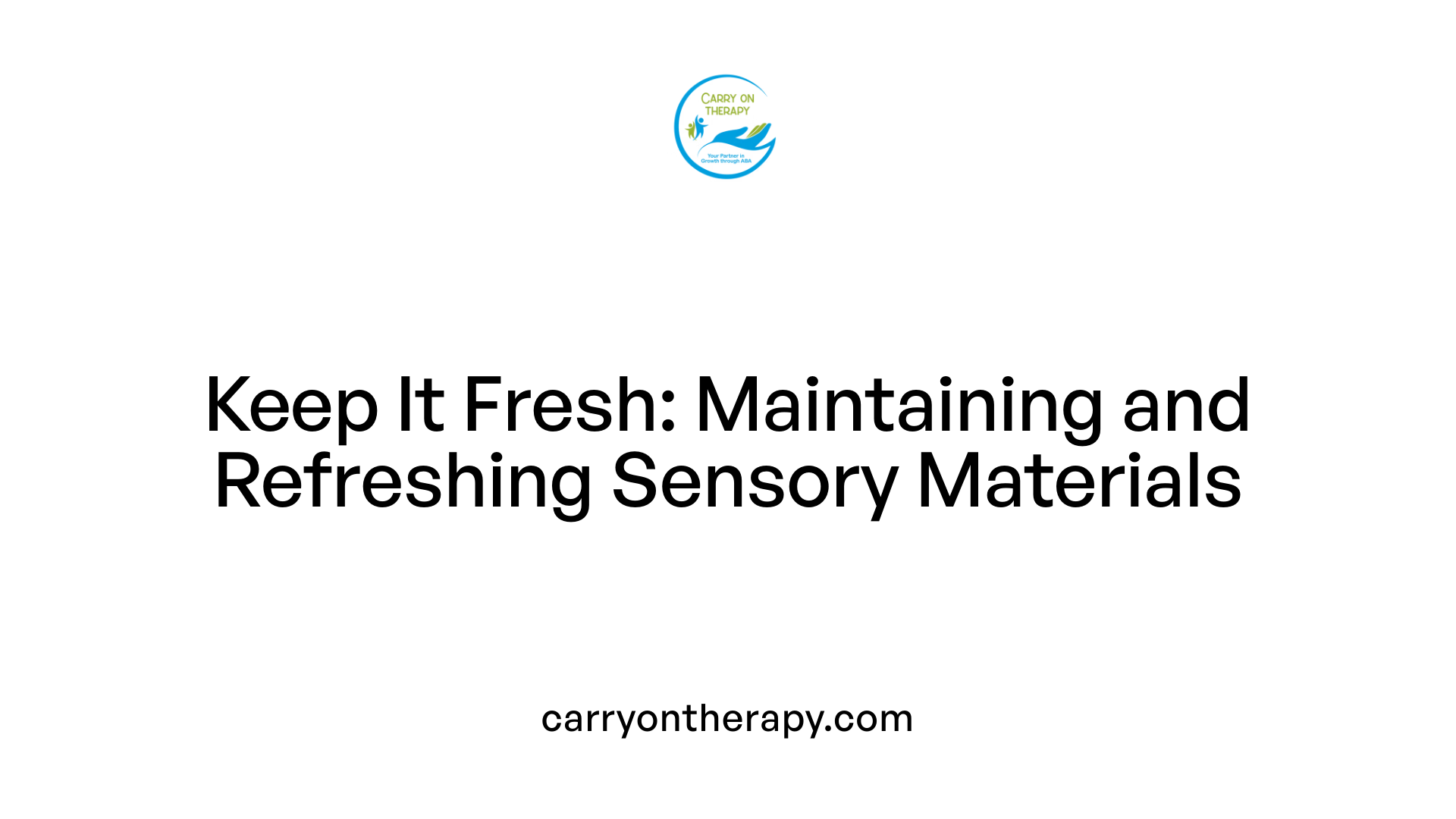
Keeping materials clean and safe
Regular cleaning of sensory bin materials is essential to ensure a safe environment for children, especially those with sensory sensitivities or disorders like pica. Using washable fillers and toys facilitates hygiene. Containers should be cleaned often, and any damaged or molded items replaced promptly to avoid health risks.
Rotating fillers and toys
To maintain interest and accommodate developmental goals, rotate fillers and toys periodically. Changing textures, colors, and themes—like shifting from dinosaurs to construction or animals—keeps sensory experiences fresh and engaging. This rotation also supports a broad range of skill development, from fine motor skills to cognitive concepts.
Maintaining engagement through novelty
Introducing new sensory experiences, such as homemade playdough, finger painting, or mini sand gardens, invites creativity and experimentation. These activities not only enhance fine motor skills and sensory processing but also provide calming, therapeutic benefits. Regularly updating the sensory table with novel textures and interactive objects helps sustain the child's focus and enthusiasm, fostering both enjoyment and developmental progress.
Measuring Progress Through Sensory Table Engagement
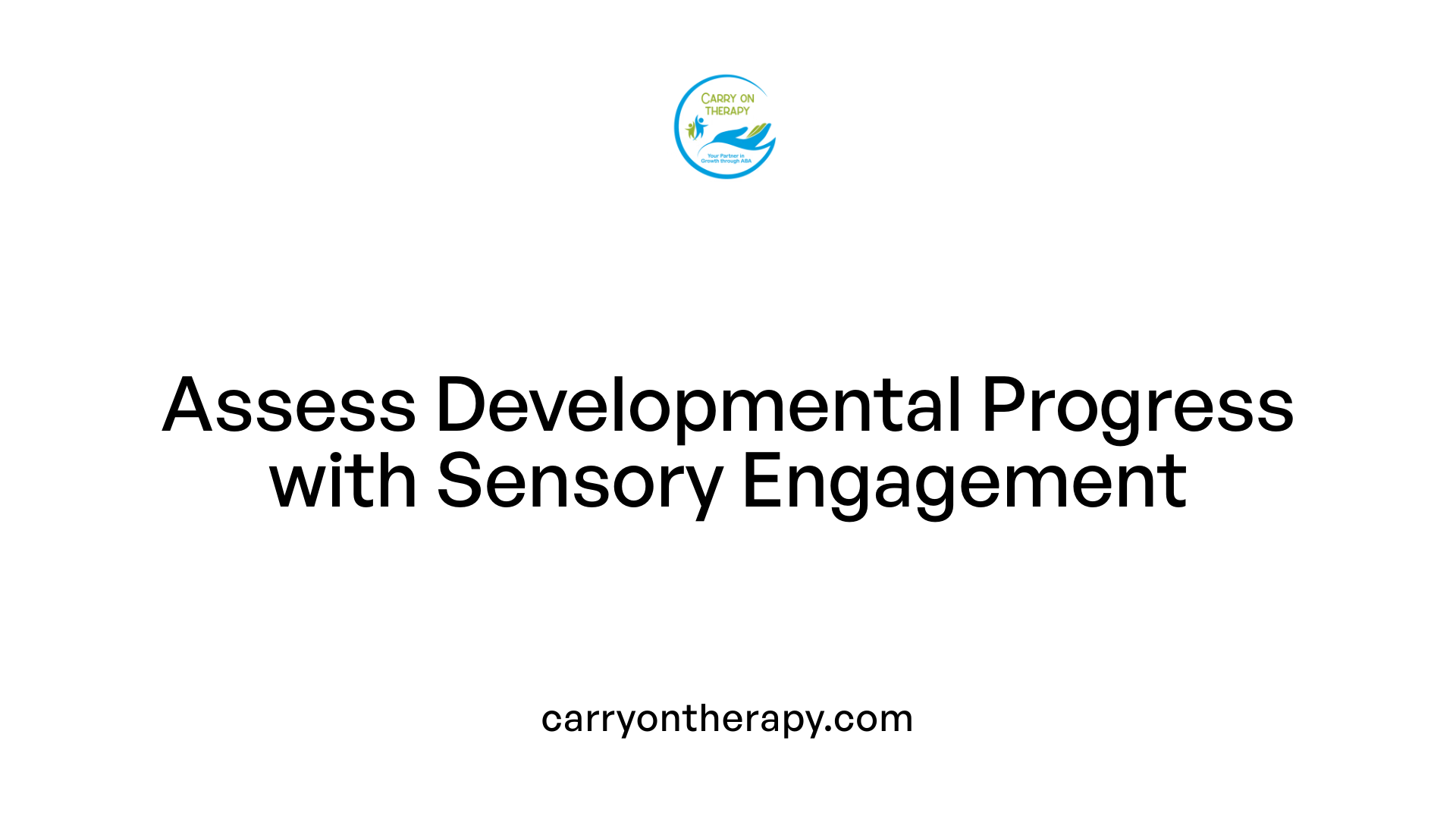
How Can Improvements in Motor and Sensory Skills Be Observed?
Engagement with sensory tables offers valuable opportunities to observe and support the development of motor and sensory skills in children. Activities such as sorting pebbles by color or shape and threading beads onto pipe cleaners help sharpen fine motor control and hand-eye coordination. Through repeated play, children often display gradual improvements in dexterity and precision.
How Is Focus and Calming Measured During Sensory Play?
Sensory bins are known for their calming benefits, particularly for children with autism. Careful observation during use can reveal increased periods of focused attention and reduced signs of distress or sensory overload. For example, children may become more engaged and less distractible when interacting with materials like mini sand gardens or finger painting. These calming effects can be tracked by noting changes in behavior and duration of play.
How Can Sensory Play Serve as a Developmental Indicator?
Regular participation in sensory table activities provides insights into a child's developmental stage. For instance, crafting pasta necklaces or stacking bricks not only enhances creativity but also signals advancing cognitive and motor skills. Parents and therapists can use sensory play progression as a metric to detect early motor skill delays or to assess sensory processing improvements. Careful tailoring of materials to individual needs ensures that observations reflect true developmental gains.
This multi-sensory engagement is not only therapeutic but also a practical tool for monitoring growth in young children, especially those with developmental challenges. By tracking specific abilities during sessions, caregivers and professionals can make informed decisions to adapt and enrich sensory play experiences accordingly.
Creating Effective Sensory Experiences for Autism Support
DIY sensory tables present a versatile, engaging, and therapeutic tool to support children with autism in managing sensory processing challenges and developing critical skills. When thoughtfully designed and integrated with interventions like ABA therapy, sensory tables become a meaningful part of a personalized therapeutic approach. Their calming effects, combined with opportunities to enhance fine motor, cognitive, and social skills, underscore their value in autism support. Tailoring sensory content to individual needs while maintaining safety and engagement can maximize potential benefits. As caregivers and professionals embrace creative sensory play, they foster a nurturing environment that promotes growth, independence, and well-being for autistic individuals.
References
- The Ultimate Sensory Bin Ideas Guide for Kids of All Ages
- Creative Sensory Play for Home: 8 Activities to Spark Your ...
- Applied Behavior Analysis (ABA)
- Applied Behavior Analysis (ABA)
- ABA 101 handouts
- ABA Techniques: Strategies for Behavior Analysts - GSEP Blog
- Applied Behavior Analysis (ABA)
- 6 Benefits of ABA Therapy for Children with Autism





